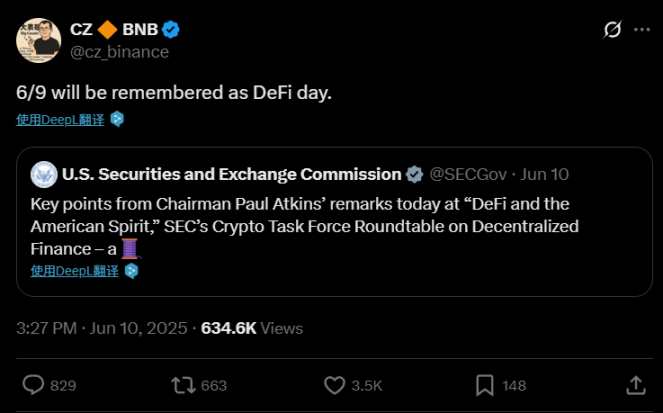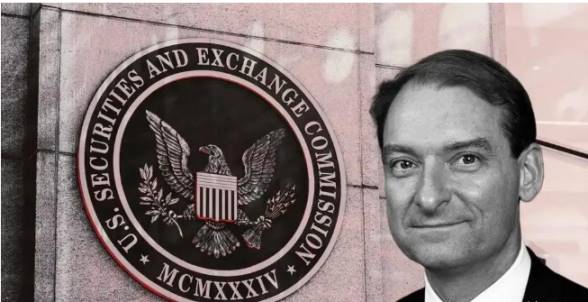Written by: Bright, Foresight News
CZ publicly stated on social media: "June 9th will be remembered as DeFi Day." Following the abolition of the "DeFi Broker Rules," crypto regulation in the United States has once again broken through a layer of shackles. Subsequently, veteran DeFi tokens such as AAVE and UNI have started a spectacular rising mode.

On June 9th US time, the "DeFi and American Spirit" speech by the new SEC Chairman Paul Atkins marked a fundamental change in US crypto regulation logic. Combined with the Ethereum Foundation's strategic adjustment and market capital resonance, ETH chain DeFi is ushering in an unprecedented structural opportunity. The three core driving forces - regulatory paradigm innovation, institutional capital inflow, and technological breakthroughs - collectively build the underlying logic of DeFi Summer 2.0's outbreak.
I. Regulatory Relaxation: Policy Catalyst for DeFi Summer 2.0
Atkins released three major regulatory signals in his June 9th speech, completely reversing the "enforcement-first" tone of the Gensler era.
First, the US SEC finally recognized the code neutrality principle. In his speech, Atkins used the analogy of "autonomous car developers should not be responsible for third-party abuse" to clearly shift the responsibility subject from tool developers to users, clearing legal obstacles for DeFi protocols' "permissionless innovation". This assertion directly responded to the Tornado Cash developer case during the previous Democratic administration, removing compliance shackles from developers. Within 24 hours after the speech, DeFi blue-chip tokens like AAVE and UNI rose by over 13%, and privacy track tokens like AZTEC rose by 9%, with the market validating the value reassessment effect of regulatory relaxation.
Second, property rights return and Staking legalization. Atkins emphasized that "private property self-management rights" are a core American value, explicitly supporting users' direct participation in on-chain financial activities through personal wallets. This statement completely ended the Gensler-era securities allegations against liquid staking protocols (LSD) like Lido and Rocket Pool. The LSD track leader LDO rose by 11% that day, and re-staking projects like EigenLayer also simultaneously rose, showing institutional capital's reconstruction of confidence in the Staking ecosystem.
Third, the innovation sandbox mechanism is landing. Similar to Dubai's DFSA, the SEC announced the establishment of an "innovation exemption" framework, allowing registered and unregistered entities to quickly launch on-chain products under compliance conditions. This mechanism provides an officially licensed experimental field for the RWA (real-world assets on-chain) domain, accelerating the process of over-trillion-dollar off-chain assets moving on-chain.

II. Core Effort: Ethereum Foundation Promotes "Defipunk"
The Ethereum Foundation's 2030 plan clearly states that it will promote the establishment of a "Defipunk" assessment mechanism and facilitate DeFi project transformation.
In the plan, the Ethereum Foundation views DeFi as the core carrier for realizing Ethereum's "permissionless, censorship-resistant" vision, explicitly promoting DeFi to become the "open financial infrastructure of the digital era" through treasury allocation, technical support, and standard setting. Its key goal is: by 2026, on-chain DeFi allocation will exceed 30% of the treasury (non-ETH core holdings), prioritizing protocols with strong privacy and composability.
Based on the cypherpunk principle, the Ethereum Foundation (EF) is promoting the establishment of a "Defipunk" assessment framework, focusing on core characteristics such as security, open-source nature, financial sovereignty, technical solution priority, and privacy protection. The aim is to cultivate a censorship-resistant DeFi ecosystem through research, advocacy, and fund allocation to address current DeFi ecosystem challenges like high privacy-related gas fees and user experience friction, and solve systemic vulnerabilities in existing DeFi that generally rely on centralized backdoors and multi-signature mechanisms.
Currently, the TVL on the ETH chain has recovered to $66 billion from the low point in February and March, showing a good expansion momentum and expected to exceed the peak of December 24 in scale.

AAVE, which has been performing well recently, has a TVL of over $26 billion, with staked ETH exceeding 9.3 million.

UNI, which surged 30% in a day, also shows impressive recent data. Its TVL has rebounded to $5.152 billion, expected to exceed the high point of 24.

III. Institutional Bullish: ETH Remains the First Choice in Crypto Compliance Context
On June 11th, according to Farside monitoring, FETH had a net inflow of $26.3 million yesterday, Grayscale ETH net inflow was $9.7 million, and ETHW net inflow was $8.4 million. Meanwhile, Ethereum staking reached a historical high of 34.8 million ETH, about 28.15% of circulating supply.
The market expects the US SEC to soon approve an Ethereum ETF supporting staking, with REX Shares having submitted a related application. BlackRock's iShares Ethereum Trust has not seen capital outflows for 23 consecutive trading days.
Recently, LD Capital founder JackYi again reaffirmed his bullish stance on Ethereum and its ecosystem tokens, stating he holds 100,000 ETH option long positions. He believes Ethereum ecosystem is underestimated due to: ETH token itself being undervalued, expecting ETH/BTC exchange rate to rebound during the bull market; after crypto policy opens up, projects with real income, users, and products will first benefit from traditional capital inflow; Wall Street funds are currently flowing into Ethereum for building positions. LD Capital's Trend Research is even more bullish on ETH, currently holding 142,000 ETH with a floating profit of $42.35 million.

QCP research report suggests that Ethereum's implied volatility is rising, with front-end at-the-money option volatility climbing to around 70%, and option market skew clearly turning bullish, rising 5 to 6 percentage points. High perpetual contract funding rates further strengthen the bullish market atmosphere. ETF capital inflows indicate institutional interest is returning. This round of capital rotation may suggest that market narrative is shifting from "Bitcoin is digital gold" to "Ethereum is the infrastructure layer for real-world assets (RWA)".
Looking ahead, macro positive factors are indeed gathering momentum for Ethereum. From the wild growth and regulatory vacuum of DeFi summer in 2020 to now, the crypto industry has completely been placed in a compliant context. With the GENIUS bill advancing in the US Senate, Circle launching IPO, and stablecoins gradually making progress in regulation, Ethereum's core position in tokenization and settlement infrastructure may usher in a structurally unexpected upside. Correspondingly, DeFi based on ETH will also soar again.





